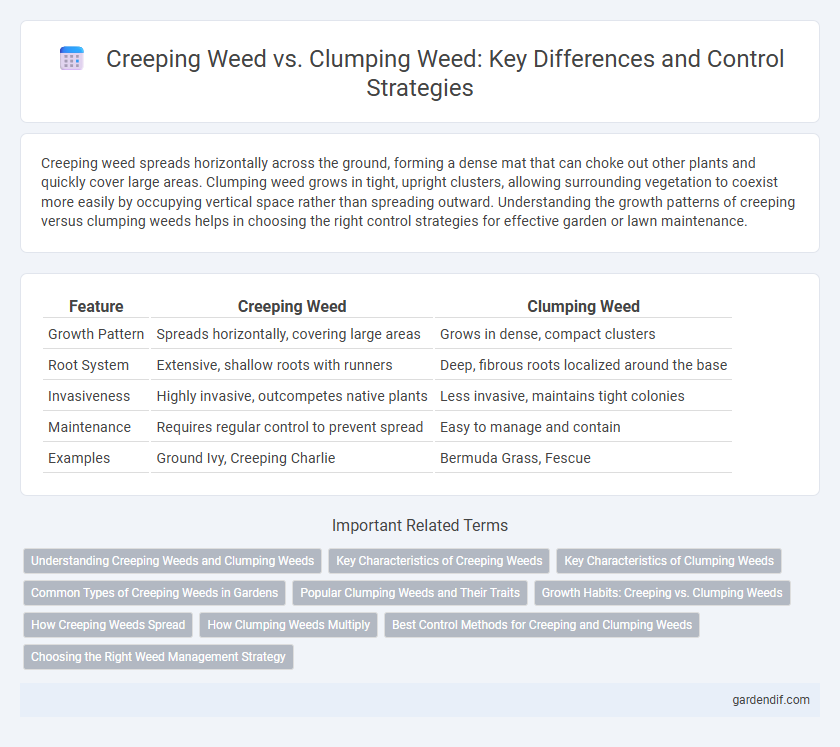
Creeping weed vs clumping weed Illustration
Creeping weed spreads horizontally across the ground, forming a dense mat that can choke out other plants and quickly cover large areas. Clumping weed grows in tight, upright clusters, allowing surrounding vegetation to coexist more easily by occupying vertical space rather than spreading outward. Understanding the growth patterns of creeping versus clumping weeds helps in choosing the right control strategies for effective garden or lawn maintenance.
Table of Comparison
| Feature | Creeping Weed | Clumping Weed |
|---|---|---|
| Growth Pattern | Spreads horizontally, covering large areas | Grows in dense, compact clusters |
| Root System | Extensive, shallow roots with runners | Deep, fibrous roots localized around the base |
| Invasiveness | Highly invasive, outcompetes native plants | Less invasive, maintains tight colonies |
| Maintenance | Requires regular control to prevent spread | Easy to manage and contain |
| Examples | Ground Ivy, Creeping Charlie | Bermuda Grass, Fescue |
Understanding Creeping Weeds and Clumping Weeds
Creeping weeds spread horizontally through runners or stolons, forming dense mats that quickly cover the ground, making them difficult to control in gardens and lawns. Clumping weeds grow in tight, upright clusters or tufts, expanding primarily from their root base without extensive horizontal spread, often allowing for easier removal. Identifying the growth patterns of creeping versus clumping weeds is essential for selecting targeted herbicide treatments and effective weed management strategies.
Key Characteristics of Creeping Weeds
Creeping weeds are characterized by their horizontal growth habit, spreading rapidly through stolons or rhizomes, which enables them to cover large areas and outcompete other plants. They possess extensive root systems that make eradication difficult and contribute to their aggressive invasiveness in lawns and gardens. Examples of creeping weeds include Bermuda grass and crabgrass, both known for their resilience and ability to thrive in various soil conditions.
Key Characteristics of Clumping Weeds
Clumping weeds grow in dense, compact clusters, making them easier to target and control compared to spreading varieties. They often have fibrous root systems that support their tight growth habit, reducing the likelihood of rapid, widespread infestation. Clumping weeds typically occupy smaller, localized areas, allowing for more efficient removal and management.
Common Types of Creeping Weeds in Gardens
Common types of creeping weeds in gardens include Bermuda grass, crabgrass, and creeping Charlie, known for their aggressive spreading habits through runners or stolons. These weeds invade garden beds by forming dense mats that choke out desirable plants and hinder soil aeration. Effective management often requires persistent removal and targeted herbicide application to prevent their rapid resurgence.
Popular Clumping Weeds and Their Traits
Popular clumping weeds such as crabgrass, barnyardgrass, and foxtail exhibit dense, tufted growth patterns that make them resilient and competitive in lawns and gardens. These clumping weeds produce multiple shoots from a single base, enabling rapid local spread while maintaining a concentrated growth area. Understanding their traits, including tolerance to mowing and variable seed production rates, aids in effective weed management and prevention strategies.
Growth Habits: Creeping vs. Clumping Weeds
Creeping weeds spread horizontally through runners or stolons, enabling rapid ground coverage and making them difficult to eradicate due to extensive root systems. Clumping weeds grow in tight, dense clusters with upright shoots, allowing targeted control but often leading to thick mats that compete aggressively with surrounding plants. Understanding these distinct growth habits is crucial for developing effective weed management strategies tailored to the specific weed type involved.
How Creeping Weeds Spread
Creeping weeds spread primarily through horizontal growth, using stolons or rhizomes to extend their roots and stems underground or along the soil surface, allowing rapid colonization of new areas. This aggressive growth mechanism enables creeping weeds like Bermuda grass and creeping Charlie to outcompete other plants by forming dense mats that choke out competitors. Their ability to regenerate from fragmented stems or roots makes eradication challenging, requiring persistent management strategies.
How Clumping Weeds Multiply
Clumping weeds multiply primarily through the expansion of dense, localized root systems called rhizomes or tubers, forming tight clusters that gradually increase in size. These weeds spread slowly but effectively by producing new shoots from underground stems, allowing them to dominate an area without rapidly dispersing seeds. This growth pattern contrasts with creeping weeds, which rely on stolons or runners to spread widely and quickly across the soil surface.
Best Control Methods for Creeping and Clumping Weeds
Effective control of creeping weeds such as Bermuda grass relies on targeted herbicide application and frequent mowing to prevent spread through stolons and rhizomes. Clumping weeds like crabgrass are best managed through pre-emergent herbicides combined with proper lawn aeration and overseeding to enhance turf density. Integrated weed management strategies that include soil health improvement and selective herbicides optimize suppression of both creeping and clumping weed species.
Choosing the Right Weed Management Strategy
Selecting the appropriate weed management strategy requires understanding the growth patterns of creeping weeds, which spread aggressively via runners and root systems, contrasting with clumping weeds that grow in localized clusters. Targeting creeping weeds demands systemic herbicides or physical barriers to restrict their extensive root networks, while clumping weeds often respond well to spot treatments or manual removal due to their contained growth. Effective control hinges on identifying the weed type to apply tailored techniques that prevent spread and promote healthy vegetation.
Creeping weed vs clumping weed Infographic

 gardendif.com
gardendif.com